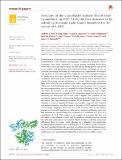Structure of the cyanobactin oxidase ThcOx from Cyanothece sp. PCC 7425, the first structure to be solved at the Diamond Light Source Beamline I23 by means of S-SAD
Abstract
Determination of protein crystal structures requires that the phases are derived independently of the observed measurement of diffraction intensities. Many techniques have been developed to obtain phases including heavy atom substitution, molecular replacement and substitution during protein expression of the amino acid methionine with selenium methionine. Although the use of selenium containing methionine has transformed experimental determination of phases it is not always possible, either because the variant protein cannot be made or does not crystallise. Phasing of structures by measuring the anomalous diffraction from sulfur atoms, could in theory be almost universal since almost all proteins contain methionine or cysteine. Indeed many structures have been solved by the so called native sulfur single-wavelength anomalous diffraction (S-SAD) phasing method. However, the anomalous effect is weak at the wavelengths where data are normally recorded (between 1 and 2 Å) and this limits the potential of this method to well diffracting crystals. Longer wavelengths increase the strength of the anomalous signal but at the cost of increasing air absorbance and scatter which degrades the precision of the anomalous measurement consequently hindering phase determination. A new instrument, the long-wavelength beamline I23 at Diamond Light Source was designed to work at significantly longer wavelengths compared to standard synchrotron beamlines to open the native S- SAD method for projects of increasing complexity. We report the first novel structure, that of the oxidase domain involved in production of the natural product patellamide, solved on this beamline using data collected at a wavelength of 3.1 Å. The oxidase is an example of a protein that does not crystallise as the selenium variant and no suitable homology model for molecular replacement was available. Initial attempts collecting anomalous diffraction data for native sulfur phasing on a standard macromolecular crystallography beamline using a wavelength of 1.77 Å did not yield large enough signal and S-SAD phasing failed. The new beamline thus has promise in facilitating structure determination by native S-SAD phasing for challenging cases with modestly diffracting crystals and low sulfur content.
Citation
Bent , A F , Mann , G , Houssen , W , Mykhaylyk , V , Duman , R , Thomas , L , Jaspars , M , Wagner , A & Naismith , J H 2016 , ' Structure of the cyanobactin oxidase ThcOx from Cyanothece sp. PCC 7425, the first structure to be solved at the Diamond Light Source Beamline I23 by means of S-SAD ' , Acta Crystallographica Section D: Structural Biology , vol. 72 , no. 11 , pp. 1174-1180 . https://doi.org/10.1107/S2059798316015850
Publication
Acta Crystallographica Section D: Structural Biology
Status
Peer reviewed
ISSN
2059-7983Type
Journal article
Description
This research was supported by grants from the UK Biotechnology and Biological Research Council (no. BB/K015508/1, J.H.N. and M.J.) and the European Research Council (no. 339367, J.H.N. and M.J.). Mass spectrometry analysis was carried out by the Biomedical Sciences Research Complex Mass Spectrometry and Proteomics Facility, University of St. Andrews and was funded by the Wellcome Trust (grant nos. 094476/Z/10/Z and WT079272AIA). J.H.N. is a Royal Society Wolfson Merit Award Holder and 1000 talent scholar at Sichuan University.Collections
Items in the St Andrews Research Repository are protected by copyright, with all rights reserved, unless otherwise indicated.

